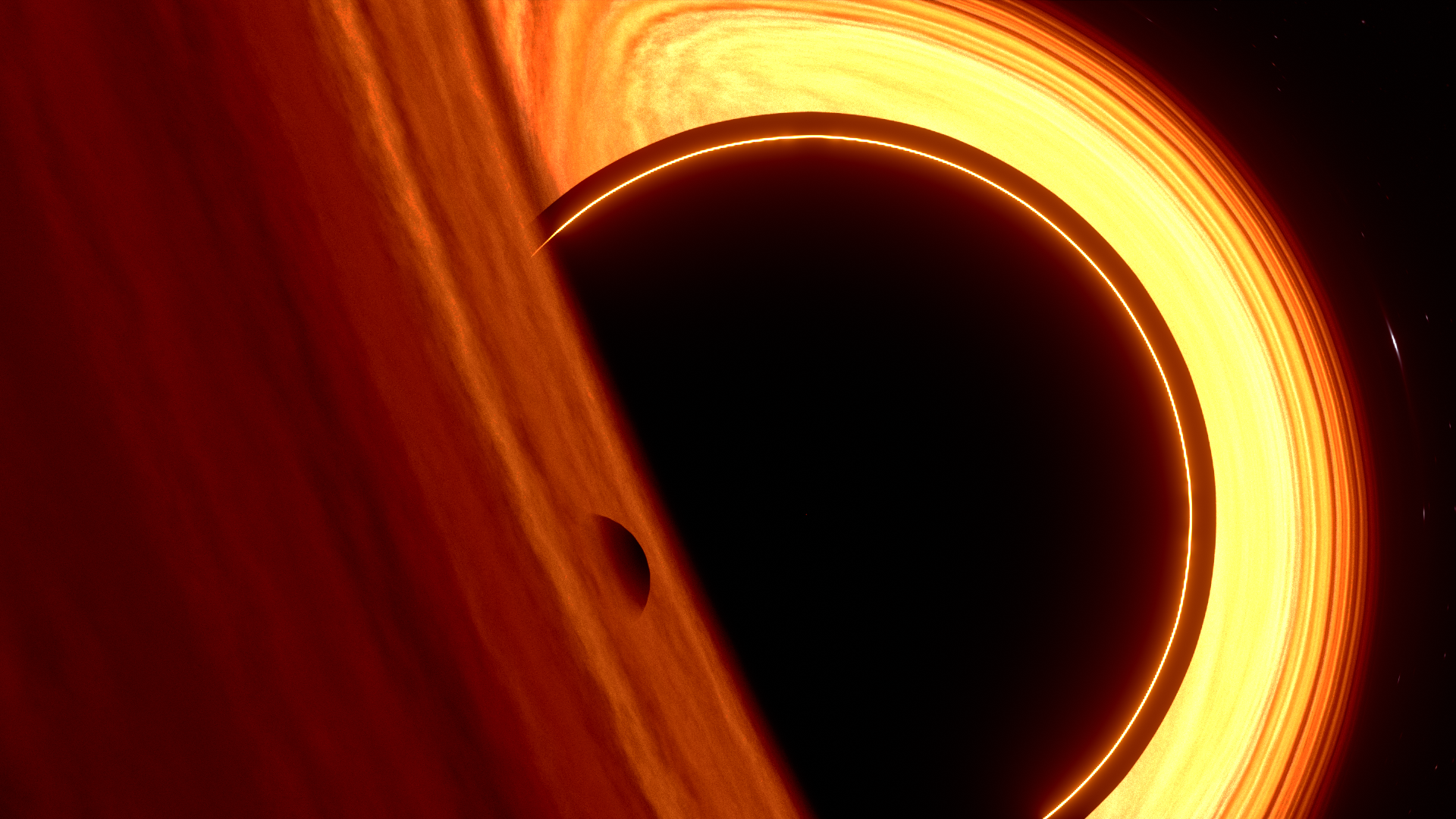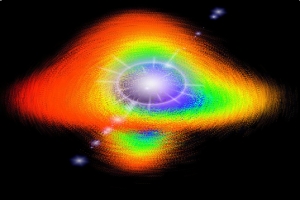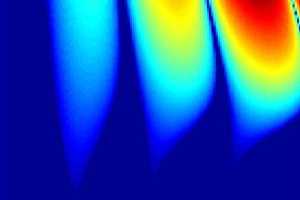

Science interests
Astronomers have been discovering black holes in numerous cosmic objects.
Black holes are difficult targets to be observed, because they do not emit radiation
like stars do. However, thanks to their extreme gravity, black holes attract gas
from the neighborhood. This gas may get very hot and provide us with
precious information about the black hole in which it falls. Research of black holes combines
results of theoretical physics with observational astronomy, and it uses
most recent technology which provides ingenious techniques and sensitive detectors.
Currently, astronomers speak about stellar-mass black holes (residing e.g. in binary
systems where the companion is a normal star);
another example concerns very massive black holes which are hidden in centers of almost all galaxies.
In some fraction of galaxies,
large amounts of gas are falling into the black hole. The gas
forms an accretion flow which often acquires a disc-like shape surrounding the hole.
Such a disc is called an accretion disc.
Figure on the right is a false colour illustration of an accretion disc around a
rotating black hole, as observed by a distant observer. Effects of
general relativity on motion of light (focusing near a black hole,
Doppler effect) have been taken into account. Some types of active galactic
nuclei and some Galactic sources are believed to contain a central black
hole surrounded by such a disc of gaseous material. We have developed an
code for calculating observed features in radiation from these objects.
In particular, the disc model explains with reasonable accuracy
the X-ray spectral properties which have been attributed to reprocessing
of light in the disc. Please find technical details in
a paper with A. Lanza & D. Vokrouhlicky (1995), and
with A. Polnarev (1992).
 We have used our computational tools for a detailed discussion of
predicted spectral features, such as varying line profiles which change
their intensity, shapes and energy with orbital phase of the pattern
on the disc surface (with A. Martocchia & G. Matt 2000, also
with L. Subr 2001) Effects of light-travel time, energy shift and gravitational
focusing near a rotating black hole are taken into account. A
high-resolution ray-tracing code is used to follow time variations of
the synthetic line profile. The variety of expected spectral features is
examined and the scheme is applied to the broad iron line observed
in MCG--6-30-15.
We have used our computational tools for a detailed discussion of
predicted spectral features, such as varying line profiles which change
their intensity, shapes and energy with orbital phase of the pattern
on the disc surface (with A. Martocchia & G. Matt 2000, also
with L. Subr 2001) Effects of light-travel time, energy shift and gravitational
focusing near a rotating black hole are taken into account. A
high-resolution ray-tracing code is used to follow time variations of
the synthetic line profile. The variety of expected spectral features is
examined and the scheme is applied to the broad iron line observed
in MCG--6-30-15.
In another paper (with A. Martocchia, G. Matt, M. Feroci & T. Belloni 2002),
se report on the discovery of a relativistic iron Kα fluorescent emission line in the BeppoSAX
spectrum of the microquasar GRS 1915+105. The line was unusually intense, the feature broad and skewed,
indicating emission from the innermost regions of the accretion disc. The inner emitting orbit
is larger than the innermost stable orbit, even in Schwarzschild metric: thus, a non-zero BH spin is
not required by these data. In another paper (with Olda Semerak & Fernando de Felice 1999),
we propose a way to deduce the parameters of accreting black holes (the method again
employs the properties of the spectral features observed in radiation from an accretion disc).
 There are viable alternatives to the standard disc-line model, and they may be
rather succesful in the end.
Certain doubts concerning the disc model for the iron-line production
revived the interest in such a possiblity. For example,
several workers propose that the line is produced by Compton scattering of the line
photons, and they show
that such a model fits the data equally well as the disc model. We thus
explored the cloud model of accretion onto a black hole where both the
line formation and Comptonization occur in the same medium including
the global effects of gravitational redhsift, clouds motion, etc
(a paper with B. Czerny, A. Abrassart & M. Abramowicz 2000).
We have discussed the possibility to explain the profile
of the iron line within the frame of the model in which the
innermost part of the disc is disrupted due to disc instabilities. Part
of the disc material forms optically thick cold clouds, while another
fraction heats up to high temperatures acting as a source of X-rays. The
clouds are not confined to the disc equatorial plane and they form a
layer covering a significant portion of the sky from the point of view
of the central X-ray source.
There are viable alternatives to the standard disc-line model, and they may be
rather succesful in the end.
Certain doubts concerning the disc model for the iron-line production
revived the interest in such a possiblity. For example,
several workers propose that the line is produced by Compton scattering of the line
photons, and they show
that such a model fits the data equally well as the disc model. We thus
explored the cloud model of accretion onto a black hole where both the
line formation and Comptonization occur in the same medium including
the global effects of gravitational redhsift, clouds motion, etc
(a paper with B. Czerny, A. Abrassart & M. Abramowicz 2000).
We have discussed the possibility to explain the profile
of the iron line within the frame of the model in which the
innermost part of the disc is disrupted due to disc instabilities. Part
of the disc material forms optically thick cold clouds, while another
fraction heats up to high temperatures acting as a source of X-rays. The
clouds are not confined to the disc equatorial plane and they form a
layer covering a significant portion of the sky from the point of view
of the central X-ray source.
 We have also examined decaying orbits in a dense cluster --
result of hydrodynamical interaction between stars and the gaseous environment
(transitions across an accretion disc, gap opening in the disc, and density
waves). This effect is compared against dissipation caused by
gravitational radiation and other processes (work with L. Subr).
We have also examined decaying orbits in a dense cluster --
result of hydrodynamical interaction between stars and the gaseous environment
(transitions across an accretion disc, gap opening in the disc, and density
waves). This effect is compared against dissipation caused by
gravitational radiation and other processes (work with L. Subr).
In a paper with T. Musil (2002),
the time evolution of an advection-dominated accretion flow is explored in terms of
relativistic fluid equations. An axially symmetric, vertically averaged mean flow is
constructed and perturbed. An axisymmetric pattern is followed as it propagates in
the form of a wave towards the horizon of a rotating black hole.
The wave reflection and steepening are examined and the influence of black hole angular
momentum is discussed.
 With M. Abramowicz, W. Kluzniak, W. Lee & P. Rebusco,
we have explored the ideas that parametric resonance affects nearly
geodesic motion around a black hole or a neutron star,
and that it may be relevant to the high-frequency (twin)
quasi-periodic oscillations that occur in some low-mass X-ray binaries.
We have assumed the particles or fluid elements of
an accretion disc to be subject to an isotropic perturbation having
a hypothetical but rather general form. We find that the
parametric resonance is indeed excited close to the radius where
epicyclic frequencies of the radial and meridional oscillations are in a
2:3 ratio. The location and frequencies of the
highest amplitude excitation vary with the strength of the perturbation.
These results agree with actual frequency ratios of twin kHz QPOs that have
been reported in some black hole candidates, and they may be consistent also
with correlation of the twin peaks in Sco X-1.
With M. Abramowicz, W. Kluzniak, W. Lee & P. Rebusco,
we have explored the ideas that parametric resonance affects nearly
geodesic motion around a black hole or a neutron star,
and that it may be relevant to the high-frequency (twin)
quasi-periodic oscillations that occur in some low-mass X-ray binaries.
We have assumed the particles or fluid elements of
an accretion disc to be subject to an isotropic perturbation having
a hypothetical but rather general form. We find that the
parametric resonance is indeed excited close to the radius where
epicyclic frequencies of the radial and meridional oscillations are in a
2:3 ratio. The location and frequencies of the
highest amplitude excitation vary with the strength of the perturbation.
These results agree with actual frequency ratios of twin kHz QPOs that have
been reported in some black hole candidates, and they may be consistent also
with correlation of the twin peaks in Sco X-1.
updated: 2024
 We have used our computational tools for a detailed discussion of
predicted spectral features, such as varying line profiles which change
their intensity, shapes and energy with orbital phase of the pattern
on the disc surface (with A. Martocchia & G. Matt 2000, also
with L. Subr 2001) Effects of light-travel time, energy shift and gravitational
focusing near a rotating black hole are taken into account. A
high-resolution ray-tracing code is used to follow time variations of
the synthetic line profile. The variety of expected spectral features is
examined and the scheme is applied to the broad iron line observed
in MCG--6-30-15.
We have used our computational tools for a detailed discussion of
predicted spectral features, such as varying line profiles which change
their intensity, shapes and energy with orbital phase of the pattern
on the disc surface (with A. Martocchia & G. Matt 2000, also
with L. Subr 2001) Effects of light-travel time, energy shift and gravitational
focusing near a rotating black hole are taken into account. A
high-resolution ray-tracing code is used to follow time variations of
the synthetic line profile. The variety of expected spectral features is
examined and the scheme is applied to the broad iron line observed
in MCG--6-30-15.




